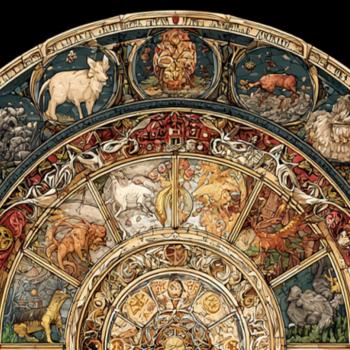
As I mentioned in my latest post, I’ll be launching a brand-new subscription-only blog series here called THE INNER CIRCLE starting this week.
Our series will cover the sayings of Jesus in the Gospel of Thomas and will most likely become the foundation for my next book project.
Here’s an introduction to give you a taste of what this weekly series will cover. If you’d like to join us, please SUBSCRIBE today to read future posts in THE INNER CIRCLE series starting with this first post in the series: The Evidence For The Early Date Of Thomas’s Gospel.
WHY THE GOSPEL OF THOMAS?
Around the turn of the twentieth century, in Egypt, three separate papyrus fragments were uncovered which included the sayings of Jesus written in Greek. Described at the time as “unknown gospels”, it wasn’t until 1945 when another, larger, collection of writings was discovered – also in Egypt – that scholars realized what they had were two copies of the Gospel of Thomas.
This text had been lost to us until those two discoveries brought this document into the light.
In addition to providing insight into the beliefs of a small religious community of non-orthodox believers from this period, it also gave us roughly 70 additional sayings of Jesus that were not known to us through the New Testament Gospels of Matthew, Mark, Luke or John.
Along with the Gospel of Thomas, that second discovery in 1945 also contained a variety of texts – mostly proto-Gnostic, Gnostic Christian, Jewish and Hermetic texts – including a fragment of Plato’s Republic [which will be a significant detail we’ll want to return to later in our series], and 40 writings [out of a total of 52] that were previously unknown to scholars.
Also found in the same collection were copies of The Gospel of Philip, and the Apocryphon of John.
Of course, the most startling of these new writings was, by far, the one, solitary copy of The Gospel of Thomas in its complete form: something no one had ever seen before.
Based on a few clues, including some letters found along with these texts, this copy of the Gospel of Thomas was dated to around the mid-fourth century.
Of course, the original authorship cannot be determined by this same method. It only means that this was around the time these writings were collected. The original writings would [obviously] have to date prior to this, but how far back we can’t be certain.
The earlier discovery of the fragments of The Gospel of Thomas were dated between 200 and 250 AD, so by comparison we can tell that these texts were known and were copied just prior to these dates.
Some of the early Church Fathers made references to a Gospel of Thomas, but since they never quoted from it directly we cannot be sure if they were talking about the same document or not.
Still, notable Christian thinkers from Origen and Hippolytus to Eusebius of Caesarea made mention of the title and mostly referred to it as heretical and foolish.
Assuming they were talking about the same collection of the sayings of Jesus as we’ve found and translated in our day, the Gospel of Thomas seems to have been misunderstood, devalued, and dismissed by the early Church in favor of the four canonical Gospels.
Oddly enough, there seems to have been a desire among those early Church Fathers to only have four Gospels – as if there was something special or even magical about the number – or as if God only wanted four because there are four directions on the compass, or four quarters in a whole number, or what have you.
What also sets The Gospel of Thomas apart from any other “Gospel” is that it does not contain any narrative or stories about Jesus. It is quite simply a collection of the sayings of Jesus – half of which already appear in the 4 Canonical Gospels.
Another feature of this Gospel of Thomas is that these sayings appear to have no intended order or flow to link them together. One saying is listed after the other without any connection to the previous or the subsequent saying.
It is, quite simply, as if someone scribbled down the words of Jesus on a piece of paper with the intention of keeping them for future study or consideration.
So, in a very strict sense, The Gospel of Thomas is not really a “Gospel” at all. At least, not in comparison to other Gospels where narrative, miracles, and theological doctrines are combined to paint a certain picture of Jesus as either the Son of God or God the Son.
Thomas is also not a truly “Gnostic” text for the very same reasons. It does not advance any particular theological arguments, at least none that align with any gnostic teachings found in the other, gnostic texts.
Thomas also contains no references to any of the miracles of Jesus, and no mention of the crucifixion, the resurrection, or even of any future eschatology. This is another detail we will want to return to later in our series, so please keep this in mind.
It took until 1954 for The Gospel of Thomas to be translated from the Egyptian Coptic into English, and that’s when the fun really began for scholars.
SOME THOUGHTS ABOUT THOMAS
Before we go too much further I’d like to offer a few theories about this text for us to consider.
First: Some scholars – including Stephen J. Patterson, Helmut Koester, and Stevan Davies – have suggested that The Gospel of Thomas could pre-date the four Canonical Gospels, or at least have been composed around the same time frame as Mark, Matthew and Luke were.
This is significant because, if true, then the Gospel of Thomas might be either the fabled Q-Document that New Testament scholars have been searching for, or at the very least is an example of a “type” of Q-Document that must have been circulating in the early First or late Second century.
NOTE: if you’re not sure what I mean by a “Q-Document”, this is a theorized collection of the sayings of Jesus that many Bible scholars believe must have been utilized by early Gospel writers since many of the sayings of Jesus found in the 3 Synoptic Gospels are nearly verbatim.
Secondly: When I first read through The Gospel of Thomas roughly five years ago out of mere curiosity, my initial reaction at the time was that it seemed like a completely nonsensical and worthless collection of the supposed sayings of Jesus.
Honestly, if it weren’t for this book on the text that I came across recently, I would most likely have never given Thomas another thought.
What book is that you may ask? Well, it’s this book by William G. Duffy called “The Hidden Gospel of Thomas” and a lot of what I’m going to cover in this upcoming series will be informed by his book.
However, I should like to add that this series will not be a cut-and-paste job either. Whereas I will refer to Duffy’s excellent work on this lost Gospel of Thomas, I will also be adding my own thoughts and, on more than one occasion, disagreeing with some of his conclusions about the text.
I will also be pulling in thoughts and ideas from various other sources as needed. For example, I’ve been reading quite a bit lately about Quantum Physics, the spiritual writings of Native American shaman, Black Elk, and even the books of Richard Rohr, and several others.
So, as we go through the Gospel of Thomas together, we’ll hopefully begin to appreciate a bit more of the wisdom of these sayings and perhaps even find other threads to pull on along the way.
I will also say that where I find Duffy’s book most helpful is in the area of decoding the text and unlocking the deeper meaning behind the words. Because, as I said above, reading The Gospel of Thomas straight, without an accurate framework, will result in coming away from the text shaking your head in disbelief, thinking, “what the hell is this guy trying to say?”
This is really where I believe we owe Duffy a huge debt of thanks. Because without his insights, I’m pretty sure these sayings would continue to vex, confuse and perplex us all. So, in many ways, he has saved The Gospel of Thomas from being thrown back into the trash heap where we found it in the first place.
A FEW MORE THOUGHTS ABOUT THOMAS
Before we move on, I should also caution you, my dear readers, not to compare the Jesus we find in this Gospel with the one you may have come to know and love in the Gospels of your New Testament.
Yes, the Jesus we find here in Thomas does have an important message for us, and he does have a certain perspective on things like the Kingdom of God, and how we should live our lives, but it might not always correlate to what you may assume the Jesus from Matthew, Mark, Luke or John might say.
Does that mean they are not the same Jesus? Who can say? If Thomas, for example, was a Q-document used by those other Canonical Gospel writers, then those writers took these sayings [or at least, some of them] and recontextualized them into a theological narrative that fit their own preconceived belief systems.
In other words, it’s entirely possible [but not proven] that these sayings in Thomas are the true sayings of the real Jesus, but without the narrative and theological framework we’ve become accustomed to hearing, the meaning of those sayings might have been misunderstood, lost or even repurposed.
It’s also possible that this Jesus we encounter in Thomas’s Gospel is a different one entirely, but, once again, we’re left to decide for ourselves which of these might be the “real” Jesus, and which might be the false one.
That’s not for me to decide.
Instead, I’ll do my best to share a few select and “new” sayings of Jesus found in the Gospel of Thomas and, using the code provided by Duffy, try to shed a bit more light on what might be of value to us, today.
CRACKING THE CODE
The very simple codex that Duffy’s book suggests to unlock the hidden wisdom of Jesus in the Gospel of Thomas is this: Jesus was speaking about non-dualism.
That’s it.
But, as simple as that sounds, once you begin to read these sayings through this filter of non-duality and the Oneness of all things, you’ll start to notice a startling and profound series of sayings that just might make you sit up and take the Gospel of Thomas a lot more seriously.
That’s what it did for me.
For example, here’s just a taste of how Duffy’s lens allows us to understand one of the more cryptic sayings of Jesus from the Gospel of Thomas:
“Jesus said, ‘Blessed is the lion that becomes a man when consumed by man; and cursed is the man whom the lion consumes, and the man becomes lion.” [Saying 7]
Okay, if you’re like me, the first time I read through Thomas it was sayings like this one that made me want to either laugh or throw the book against the wall…or both.
But, then when we re-read this saying again through Duffy’s filter of non-duality, we discover some pretty astounding truth hidden deep in this proverb.
First of all, both the “man” and the lion” here are not literal references. The “man” here refers to the true man within each of us; our true Self, if you will.
Secondly, the “lion” here is, in contrast, is a metaphor for the false self; the Ego, as we may know it today.
The Lion of our Ego fights to be in control, devours its enemies, and accepts the false notion of an “Us and Them” universe.
The Man of our True Self recognizes the illusion of duality and knows that the truth is found in the reality that we are not separate but are one with the Source, and, therefore, with all things.
So, Jesus is telling us that when our Ego, which is driven by fear, is consumed, it becomes subdued by the peaceful, free and innocent “True Self” which realizes its own Oneness with everyone and everything.
I can hear all of you right now saying, “Oh come on, Keith! Seriously? How did you get all of that out of such a simple proverb about a man consuming a lion?”
This is the good part.
In Plato’s Republic, the mind is represented by three metaphors: The Man, the Lion, and the Chimera [or the many-headed beast]. As Plato explains, the Lion and the Many-Headed Beast are metaphors for mankind’s lower nature, and the Man is a metaphor for our higher selves.
So what? You might ask. What does Plato have to do with Thomas?
Well, if you remember above I mentioned that a fragmented copy of Plato’s Republic was found in the very same collection as The Gospel of Thomas in 1945.
Now, guess which section of Plato’s Republic was found alongside Thomas’s Gospel in that Nag Hammadi fragment.
Yes, indeed, it was this very same section of Plato’s Republic which explains this metaphor of Lion, Man and Many-Headed Beast.
Now, are you convinced?
This is only the beginning, my friends. There is so much more to uncover in the saying of Jesus from the Gospel of Thomas. I’m very excited to dive deeper into this with all of you.
I hope you’ll come along for the ride and join me.
This is going to be so good.
**
Keith Giles is the author of the 7-part best-selling “Jesus Un” book series from Quoir Publishing. His latest -and final book – in this series, Jesus Unarmed: How The Prince Of Peace Disarms Our Violence is available now. Keith is also the host of Second Cup with Keith [a new solo podcast available now on the Ethos Radio App, for Apple and Android and on Spotify; and the Heretic Happy Hour Podcast [along with co-hosts Matthew Distefano, Dr. Katy Valentine, and Derrick Day], and the new Apostate’s Anonymous podcast with Matthew Distefano. He and his wife, Wendy, currently live in El Paso, TX.













